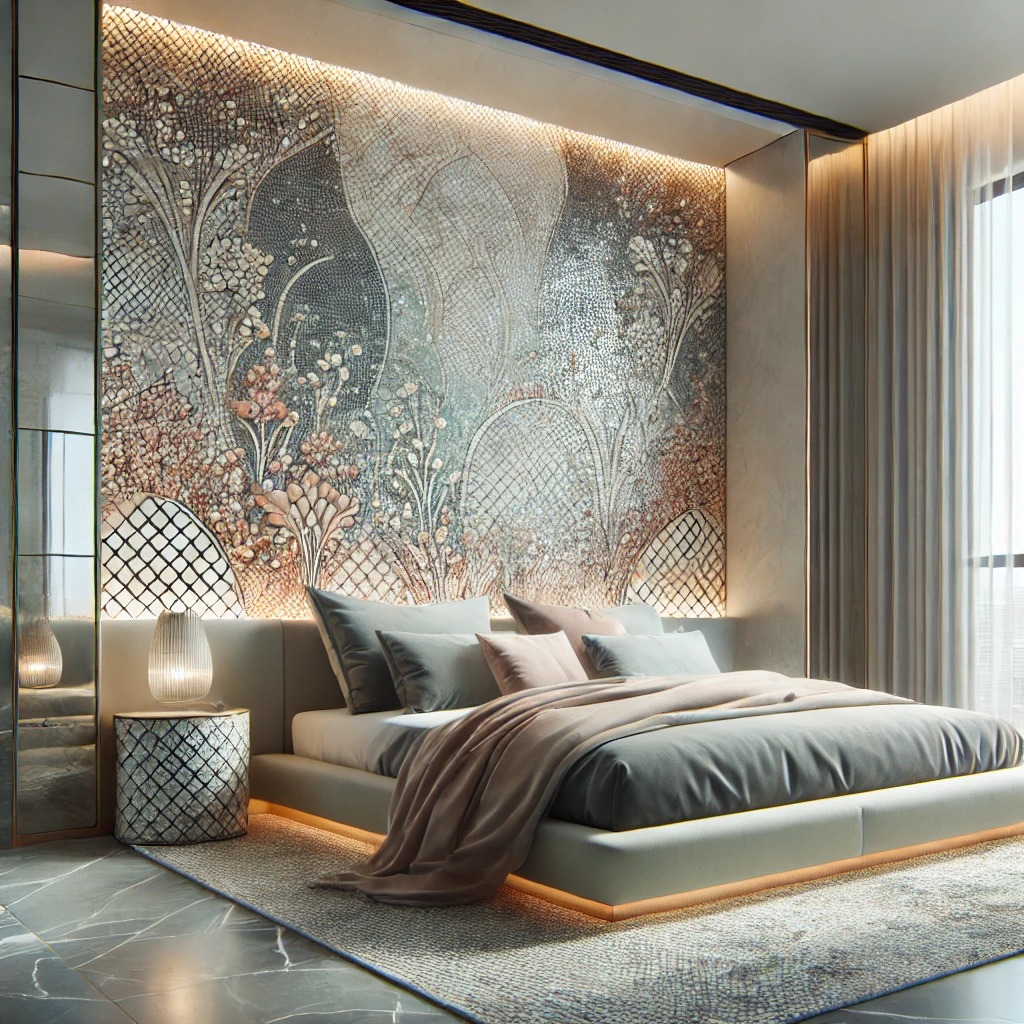Introduction
Mosaic tiles, traditionally used in bathrooms and kitchens, are now finding their way into more intimate spaces like bedrooms. These versatile tiles can be used to add a touch of luxury, texture, and color to various elements within the bedroom. This guide explores the innovative ways to incorporate mosaic tiles into bedroom design, offering both aesthetic appeal and functional benefits.
1. Enhancing the Headboard Area
- Mosaic Tile Headboards: One of the most striking ways to use mosaic tiles in a bedroom is by creating a mosaic tile headboard. Whether it’s a full wall installation or a smaller, framed area, a mosaic headboard can serve as a stunning focal point in the room. Glass, stone, or metallic mosaics work particularly well, reflecting light and adding depth to the space.
- Accent Walls: For those who prefer a more subtle approach, consider using mosaic tiles to create an accent wall behind the bed. This can be a continuous pattern or a custom design that complements the room’s color scheme. The use of natural stone or ceramic mosaics can bring warmth and a touch of nature indoors.
2. Decorative Borders and Frames
- Mirror Frames: Mosaic tiles can be used to frame mirrors in the bedroom, adding a decorative touch that elevates the overall design. A mosaic-framed mirror not only enhances the aesthetic but also creates a sense of continuity if similar tiles are used elsewhere in the room.
- Artwork and Picture Frames: Customizing artwork or picture frames with mosaic tiles can unify the room’s decor. This is an excellent way to tie together different design elements within the space, making the room feel cohesive and thoughtfully designed.
3. Flooring with a Difference
- Mosaic Tile Inlays: While hardwood or carpet flooring is common in bedrooms, mosaic tile inlays can add a unique touch. Consider adding a mosaic border around the room or creating a central medallion to draw attention. These inlays can be particularly effective in defining different zones within larger bedrooms or open-plan spaces.
- Area Rugs: For a less permanent option, consider using mosaic tiles to create an area rug effect directly on the floor. This can be an interesting alternative to traditional rugs, especially in spaces where a durable, easy-to-clean surface is needed.
4. Furniture Accents
- Bedside Tables and Dressers: Incorporating mosaic tiles into furniture design can add texture and interest to otherwise plain pieces. The top surfaces of bedside tables, dressers, or even a vanity can be adorned with mosaic tiles to create a custom, artisanal look.
- Headboard Panels: For a more understated use of mosaic tiles, consider incorporating them into panels on a wooden or upholstered headboard. This adds an element of surprise and elegance without overwhelming the design.
5. Wall Niches and Shelving
- Decorative Niches: Wall niches lined with mosaic tiles can serve both as functional shelves and decorative elements. These niches can be used to display art, books, or personal items while adding a touch of luxury with the intricate tile work.
- Shelving Backsplashes: For open shelving in the bedroom, consider adding a mosaic tile backsplash. This not only protects the wall but also creates a beautiful backdrop for the items on display. Glass or metallic mosaics can add a reflective quality, enhancing the room’s lighting.
6. Window Treatments and Sills
- Mosaic Window Sills: Adding mosaic tiles to window sills can enhance the architectural features of the bedroom. This small detail can bring in color and texture, especially when using natural materials like stone or ceramic.
- Window Surrounds: Mosaic tiles can also be used around windows to frame the view and add a decorative touch. This is particularly effective in bedrooms with a view, where the eye is naturally drawn to the window.
7. Incorporating Color and Texture
- Color Schemes: Mosaic tiles offer a wide range of colors and finishes, making them ideal for creating a specific mood in the bedroom. Soft pastels can create a calming atmosphere, while bold, vibrant colors can energize the space.
- Texture Play: The texture of mosaic tiles can add dimension to a bedroom, making it feel more dynamic. Mixing matte and glossy finishes, or smooth and rough textures, can create a visually interesting environment that engages the senses.
Conclusion
Mosaic tiles provide endless possibilities for enhancing bedroom design, offering a unique combination of beauty and functionality. Whether used as a focal point, a subtle accent, or a practical solution, mosaic tiles can transform a bedroom into a luxurious retreat. By carefully selecting the right materials, colors, and patterns, and integrating them thoughtfully into the design, you can create a space that is both personal and timeless.



